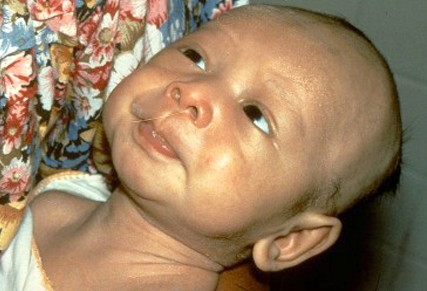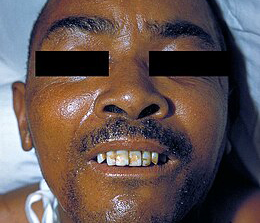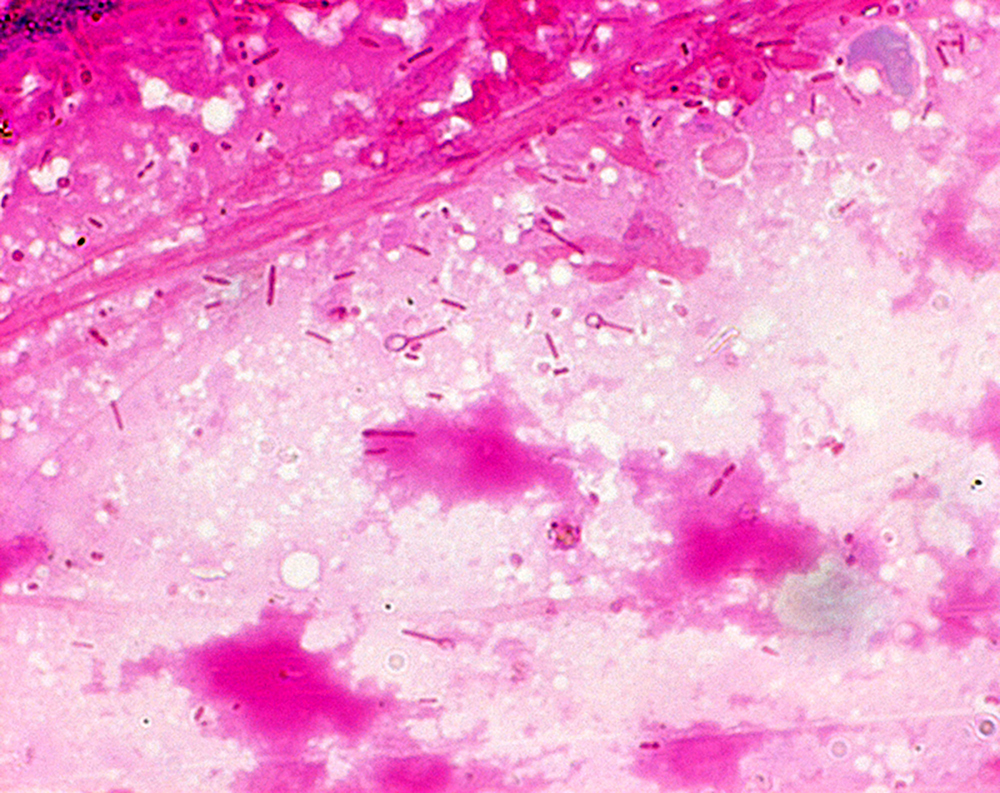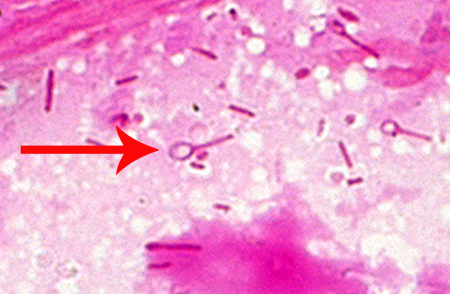♦ What is tetanus?
Tetanus, also known as lockjaw, is a bacterial infection caused by Clostridium tetani and characterized by muscle spasms.
In the most common type, the spasms begin in the jaw, and then progress to the rest of the body. Each spasm usually lasts for a few minutes. Spasms occur frequently for three to four weeks.
Some spasms may be severe enough to fracture bones.
♦ Natural habitat
C. tetani is commonly found in soil, saliva, dust, and manure.
♦ Cause
The bacteria generally enter through a break in the skin, such as a cut or puncture wound caused by a contaminated object.
They produce toxins that interfere with normal muscle contractions.
Due to C. tetani being an anaerobic bacterium, it and its endospores thrive in environments that lack oxygen, such as a puncture wound. With the changes in oxygen levels, the drumstick-shaped endospore can quickly spread.
The spores can also be found on skin surfaces and in contaminated heroin.
Rarely, tetanus can be contracted through surgical procedures, intramuscular injections, compound fractures, and dental infections. Animal bites can transmit tetanus.
Diagnosis is based on the presenting signs and symptoms.
♦ Signs and symptoms
Tetanus often begins with mild spasms in the jaw muscles—also known as lockjaw. Similar spasms can also be a feature of trismus.
The spasms can also affect the facial muscles, resulting in an appearance called risus sardonicus. Chest, neck, back, abdominal muscles, and buttocks may be affected. Back muscle spasms often cause arching, called opisthotonus. Sometimes, the spasms affect muscles utilized during inhalation and exhalation, which can lead to breathing problems.
Prolonged muscular action causes sudden, powerful, and painful contractions of muscle groups, called tetany. These episodes can cause fractures and muscle tears. Other symptoms include fever, headache, restlessness, irritability, feeding difficulties, breathing problems, burning sensation during urination, urinary retention, and loss of stool control.
Even with treatment, about 10% of people who contract tetanus die. The mortality rate is higher in unvaccinated individuals, and in people over 60 years of age.
♦ Incubation period
The incubation period of tetanus may be up to several months, but is usually about ten days.
In general, the farther the injury site is from the central nervous system, the longer the incubation period. However, shorter incubation periods will have more severe symptoms.
In trismus nascentium (i.e. neonatal tetanus), symptoms usually appear from 4 to 14 days after birth, averaging about 7 days.
On the basis of clinical findings, 4 different forms of tetanus have been described.
1_Generalized tetanus
Generalized tetanus is the most common type of tetanus, representing about 80% of cases. The generalized form usually presents with a descending pattern. The first sign is trismus or lockjaw, then facial spasms (called risus sardonicus), followed by stiffness of the neck, difficulty in swallowing, and rigidity of pectoral and calf muscles.
Other symptoms include elevated temperature, sweating, elevated blood pressure, and episodic rapid heart rate. Spasms may occur frequently and last for several minutes, with the body shaped into a characteristic form called opisthotonos. Spasms continue for up to four weeks, and complete recovery may take months.
2_Neonatal tetanus
Neonatal tetanus (trismus nascentium) is a form of generalized tetanus that occurs in newborns, usually those born to mothers who themselves have not been vaccinated. If the mother has been vaccinated against tetanus, the infants acquire passive immunity, and are thus protected. It usually occurs through infection of the unhealed umbilical stump, particularly when the stump is cut with a non-sterile instrument.
3_Local tetanus
Local tetanus is an uncommon form of the disease, in which people have persistent contraction of muscles in the same anatomic area as the injury. The contractions may persist for many weeks before gradually subsiding.
Local tetanus is generally milder; only about 1% of cases are fatal, but it may precede the onset of generalized tetanus.
4_Cephalic tetanus
Cephalic tetanus is the rarest form of the disease (0.9–3% of cases), and is limited to muscles and nerves in the head. It usually occurs after trauma to the head area, including: skull fracture, laceration, eye injury, dental extraction, and otitis media, but it has been observed from injuries to other parts of the body.
Paralysis of the facial nerve is most frequently implicated, which may cause lockjaw, facial palsy, or ptosis, but other cranial nerves can also be affected.
♦ Diagnosis
There are currently no blood tests for diagnosing tetanus.
The diagnosis is based on the presentation of tetanus symptoms, and does not depend upon isolation of the bacterium, which is recovered from the wound in only 30% of cases, and can be isolated from people without tetanus.
Laboratory identification of C. tetani can be demonstrated only by production of tetanospasmin in mice. Having recently experienced head trauma may indicate cephalic tetanus if no other diagnosis has been made.
The "spatula test" is a clinical test for tetanus that involves touching the posterior pharyngeal wall with a soft-tipped instrument and observing the effect.
A positive test result is the involuntary contraction of the jaw (biting down on the "spatula"), and a negative test result would normally be a gag reflex attempting to expel the foreign object.
A short report in The American Journal of Tropical Medicine and Hygiene states that, in an affected subject research study, the spatula test had a high specificity (zero false-positive test results) and a high sensitivity (94% of infected people produced a positive test).
♦ Prevention
Unlike many infectious diseases, recovery from naturally acquired tetanus does not usually result in immunity. This is due to the extreme potency of the tetanospasmin toxin.
Tetanospasmin will likely be lethal before it will provoke an immune response.
Tetanus can be prevented by vaccination with tetanus toxoid.
The CDC recommends that adults receive a booster vaccine every ten years, and standard care practice in many places is to give the booster to any person with a puncture wound who is uncertain of when he or she was last vaccinated, or if he or she has had fewer than three lifetime doses of the vaccine.
The booster may not prevent a potentially fatal case of tetanus from the current wound, however, as it can take up to two weeks for tetanus antibodies to form.
In children under the age of seven, the tetanus vaccine is often administered as a combined vaccine, DPT/DTaP vaccine, which also includes vaccines against diphtheria and pertussis.
For adults and children over seven, the Td vaccine (tetanus and diphtheria) or Tdap (tetanus, diphtheria, and acellular pertussis) is commonly used.
♦ Etymology
The word tetanus comes from the Ancient Greek: τέτανος, romanized: tetanos, lit. 'taut', which is further from the Ancient Greek: τείνειν, romanized: teinein, lit. 'to stretch'.
Tetanus
Related
References
CDC Center for Disease Control and Prevention
https://www.cdc.gov/tetanus/index.html
Wikipedia
https://en.wikipedia.org/wiki/Tetanus
Photos
MMIZ, ErasmusMC, Rotterdam_Loes van Damme
BA: C. tetani
https://www.chegg.com/homework-help/questions-and-answers/present-case-study-clostridium-tetani-specifics-include-patient-history-lab-media-identifi-q90109865
Wikipedia
neonatal tetanus
risus sardonicus
https://vaccineinformation.org/tetanus/photos.asp

- Actinomycosis
- Anthrax
- Biopsy Sinusitis_Aspergillus flavus
- Botulism
- Brucellosis
- Cat Scratch Disease
- Cellulitis
- Cholera
- Creutzfeldt-Jakob Disease
- Cystic Fibrosis_CF
- Diphtheria
- Erysipelas
- Erysipeloid or fish poison
- Legionnaires disease
- Lemierre syndrome
- Leprosy
- Listeriosis
- Lyme / Borreliosis
- Melioidosis
- Meningitis
- Plague
- Syphilis
- Tetanus
- Trench Mouth_Plaut-Vincent_acute necrotizing ulcerative gingivitis
- Tuberculosis (TB)
- Tularemia_Rabbit Fever
- Typhoid fever (Epidemic typhus)
- Whooping Cough







